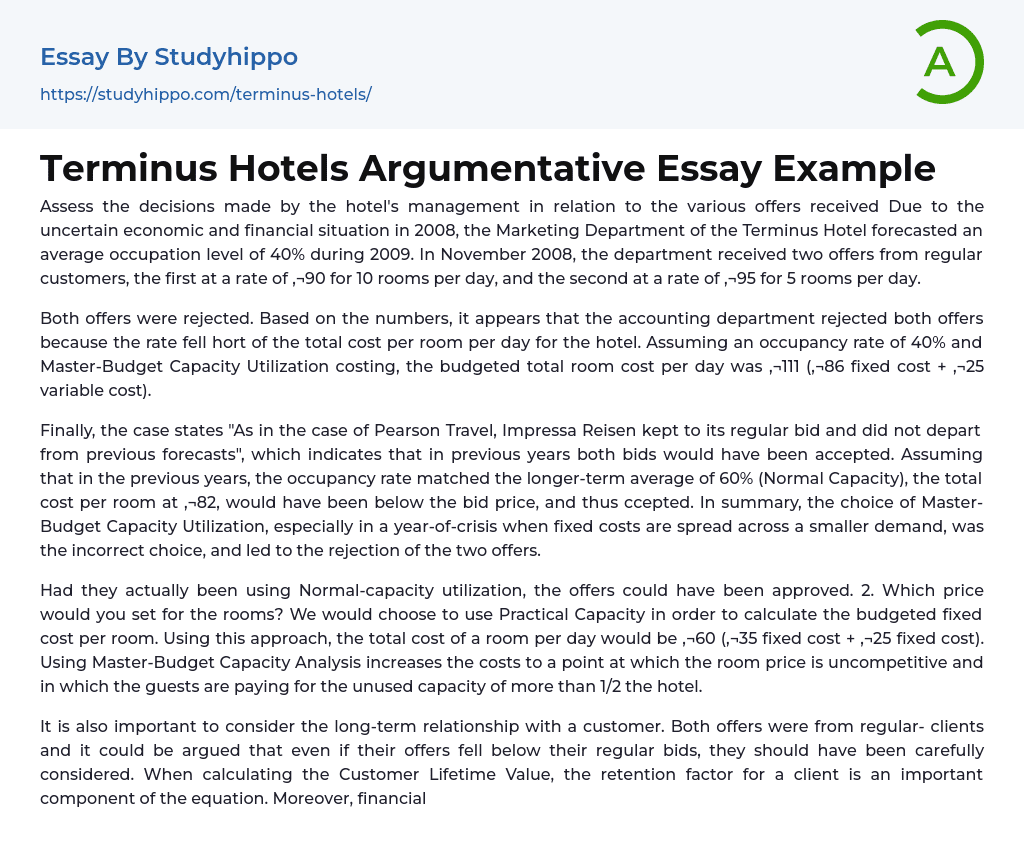Assess the decisions made by the hotel's management in relation to the various offers received Due to the uncertain economic and financial situation in 2008, the Marketing Department of the Terminus Hotel forecasted an average occupation level of 40% during 2009. In November 2008, the department received two offers from regular customers, the first at a rate of ‚¬90 for 10 rooms per day, and the second at a rate of ‚¬95 for 5 rooms per day.
Both offers were rejected. Based on the numbers, it appears that the accounting department rejected both offers because the rate fell hort of the total cost per room per day for the hotel. Assuming an occupancy rate of 40% and Master-Budget Capacity Utilization costing, the budgeted total room cost per day was ‚¬111 (‚¬86 fixed cost + ‚¬25 variable cost).
gn="justify">Finally, the case states "As in the case of Pearson Travel, Impressa Reisen kept to its regular bid and did not depart from previous forecasts", which indicates that in previous years both bids would have been accepted. Assuming that in the previous years, the occupancy rate matched the longer-term average of 60% (Normal Capacity), the total cost per room at ‚¬82, would have been below the bid price, and thus ccepted. In summary, the choice of Master-Budget Capacity Utilization, especially in a year-of-crisis when fixed costs are spread across a smaller demand, was the incorrect choice, and led to the rejection of the two offers.
Had they actually been using Normal-capacity utilization, the offers could have been approved. 2. Which price would you set for the rooms? We would choose to use Practical Capacity in order to
calculate the budgeted fixed cost per room. Using this approach, the total cost of a room per day would be ‚¬60 (‚¬35 fixed cost + ‚¬25 fixed cost). Using Master-Budget Capacity Analysis increases the costs to a point at which the room price is uncompetitive and in which the guests are paying for the unused capacity of more than 1/2 the hotel.
It is also important to consider the long-term relationship with a customer. Both offers were from regular- clients and it could be argued that even if their offers fell below their regular bids, they should have been carefully considered. When calculating the Customer Lifetime Value, the retention factor for a client is an important component of the equation. Moreover, financial benefit can be made on any price that is above the direct cost, which in this instant is the ‚¬25 variable cost, signifying benefit on any price above hotel makes a profit from the restaurant business.
This as well should be included in determining the Average Daily Spend for a guest, over and above the room rate. Considering the financial statements provided in case A, if we take the operating profit divided by the days per year and average occupancy rate, the average profit per room was ‚¬14. 25. Adding this to the total cost associated with Practical Capacity, he target price per room could be ‚¬75. 50, which would result in a margin of 24%, at the high-end of the industry (Lloyds August 2008 Hotel ; Catering Review).
At this price, the offers look solid and should be accepted. In conclusion, assuming practical costing and an alignment of prices with previous bids,
a price of ‚¬90 is reasonable. However, due to the economic climate and the use of practical costing, there is room for reducing margin and to price competitively at ‚¬75. Alternatively, a more complex approach to price setting and maximizing the returns of the hotel over the year could e taken. Revenue yield management technologies, such as those offered by Yeelders (http://yeelders. om), permit even a single hotel to take advantage of the strategies used by their much larger chain rivals. By gauging the length of stay, non- refundable rate, or time to arrival, together with a measure of demand that is based on booking patterns, seasonality, and information from local ; international markets, an optimum price can be calculated. This of course should be done in combination with maximizing revenue channels: last minute deals, packages, and holiday sales.
- Chief Executive Officer essays
- Convenience Store essays
- Firm essays
- Training And Development essays
- Unilever essays
- Variable Cost essays
- Virgin Group essays
- Bargaining essays
- Entity essays
- Pest analysis essays
- John Locke essays
- 9/11 essays
- A Good Teacher essays
- A Healthy Diet essays
- A Modest Proposal essays
- A&P essays
- Academic Achievement essays
- Achievement essays
- Achieving goals essays
- Admission essays
- Advantages And Disadvantages Of Internet essays
- Alcoholic drinks essays
- Ammonia essays
- Analytical essays
- Ancient Olympic Games essays
- APA essays
- Arabian Peninsula essays
- Argument essays
- Argumentative essays
- Art essays
- Atlantic Ocean essays
- Auto-ethnography essays
- Autobiography essays
- Ballad essays
- Batman essays
- Binge Eating essays
- Black Power Movement essays
- Blogger essays
- Body Mass Index essays
- Book I Want a Wife essays
- Boycott essays
- Breastfeeding essays
- Bulimia Nervosa essays
- Business essays
- Business Process essays
- Canterbury essays
- Carbonate essays
- Catalina de Erauso essays
- Cause and Effect essays
- Cesar Chavez essays




